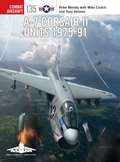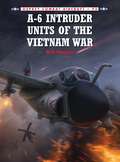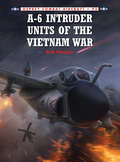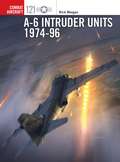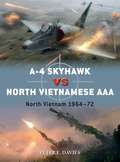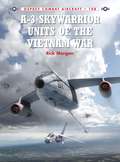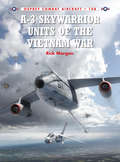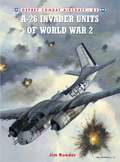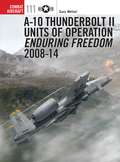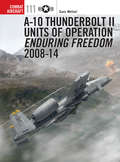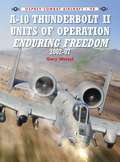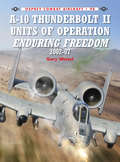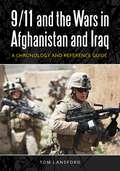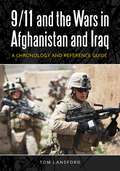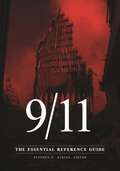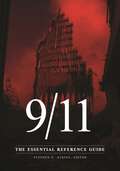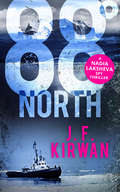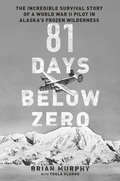- Table View
- List View
A-7 Corsair II Units 1975-91 (Combat Aircraft)
by Peter MerskyAt the A-7 Corsair II's peak in the mid-1980s, some 30 US Navy squadrons flew various versions of the aircraft, including six Naval Air Reserve units, and these many of these units saw action across the Middle East. By the time the jet saw combat in Operation Desert Storm (1991), there remained only two fleet squadrons – many fleet squadrons having either disestablished or transitioned to the F/A18 Hornet – but both of these units (VA-46 and VA-72) played a major role in the campaign to free Kuwait. The book details the technological development and improvements that were introduced to the airframe post-Vietnam (the FLIR targeting pod from 1979 and AGM-88 HARM missile from 1983 being the most important), and how they shaped operational employment of the aircraft. The jet's combat experiences in conflicts during the 1970s (Cambodia), 1980s (Lebanon, Grenada, Libya and Iran), and 1990s (Iraq) are explained in detail, and Peter Mersky's expert analysis is supported by numerous first-hand accounts from naval aviators that saw action with the A-7 during these campaigns.
A-6 Intruder Units of the Vietnam War (Combat Aircraft)
by Jim Laurier Rick MorganDesigned in the years following the Korean War and then manufactured for over 30 years starting in 1960, the A-6 quickly became the most capable attack aircraft in the US Navy's stable. The first squadron, VA-75, made its initial deployment directly into combat in south-east Asia in 1965, and, over the next eight years, ten US Navy and four Marine Intruder squadrons would conduct combat operations throughout Vietnam, Laos and Cambodia. After initial problems and a high loss rate, the type proved itself beyond all doubt as the Naval services' best night and foul-weather platform, particularly during the region's notorious monsoon season. The A-6 Intruder became a true classic of naval aviation over the skies of North Vietnam but the cost was high as 69 Intruders were lost in combat to all causes during the war. This work tells the complete story of these aircraft in combat during the Vietnam War.
A-6 Intruder Units of the Vietnam War (Combat Aircraft)
by Jim Laurier Rick MorganDesigned in the years following the Korean War and then manufactured for over 30 years starting in 1960, the A-6 quickly became the most capable attack aircraft in the US Navy's stable. The first squadron, VA-75, made its initial deployment directly into combat in south-east Asia in 1965, and, over the next eight years, ten US Navy and four Marine Intruder squadrons would conduct combat operations throughout Vietnam, Laos and Cambodia. After initial problems and a high loss rate, the type proved itself beyond all doubt as the Naval services' best night and foul-weather platform, particularly during the region's notorious monsoon season. The A-6 Intruder became a true classic of naval aviation over the skies of North Vietnam but the cost was high as 69 Intruders were lost in combat to all causes during the war. This work tells the complete story of these aircraft in combat during the Vietnam War.
A-6 Intruder Units 1974-96 (Combat Aircraft)
by Jim Laurier Rick Morgan Gareth HectorIn the three decades following Vietnam, the veteran A-6 Intruder remained the most powerful strike aircraft available to the US Navy and Marine Corps. Engaged in operations over Cambodia, Lebanon and Libya during the 1970s and 80s, the A-6 maintained its reputation as the 'Main Battery' of carrier aviation, remaining in service through the First Gulf War up until 1996 when its duties were taken over by the F-14 Tomcat. Following on from his study of the A-6 Intruder's exploits during the Vietnam War, Rick Morgan details the technological developments that were introduced to the airframe after that conflict and how it shaped the operational employment of the aircraft. Filled with first-hand accounts from pilots and navigators, as well as profile artwork and photographs, this is the complete story of the US Navy's main medium attack aircraft in the latter part of the Cold War.
A-6 Intruder Units 1974-96 (Combat Aircraft #121)
by Jim Laurier Rick Morgan Gareth HectorIn the three decades following Vietnam, the veteran A-6 Intruder remained the most powerful strike aircraft available to the US Navy and Marine Corps. Engaged in operations over Cambodia, Lebanon and Libya during the 1970s and 80s, the A-6 maintained its reputation as the 'Main Battery' of carrier aviation, remaining in service through the First Gulf War up until 1996 when its duties were taken over by the F-14 Tomcat. Following on from his study of the A-6 Intruder's exploits during the Vietnam War, Rick Morgan details the technological developments that were introduced to the airframe after that conflict and how it shaped the operational employment of the aircraft. Filled with first-hand accounts from pilots and navigators, as well as profile artwork and photographs, this is the complete story of the US Navy's main medium attack aircraft in the latter part of the Cold War.
A-4 Skyhawk vs North Vietnamese AAA: North Vietnam 1964–72 (Duel)
by Peter E. DaviesWhile the F105 Thunderchief was the USAF's principal strike weapon during the Rolling Thunder campaign, the US Navy relied on the Douglas A-4 Skyhawk for the majority of its strikes on North Vietnam. The Skyhawk entered service in 1956 and remained in continuous production for 26 years. Throughout Operation Rolling Thunder it was the US Navy's principal daytime light strike bomber, remaining in use after its replacement, the more sophisticated A-7 Corsair II, began to appear in December 1967. During the 1965–68 Rolling Thunder period, up to five attack carriers regularly launched A-4 strike formations against North Vietnam. These formations faced an ever-expanding and increasingly coordinated Soviet-style network of anti-aircraft artillery missiles and fighters. Skyhawk pilots were often given the hazardous task of attacking anti-aircraft defences and to improve accuracy, they initially dropped ordnance below 3000 ft in a 30-degree dive in order to bomb visually below the persistent low cloud over North Vietnam, putting the aircraft within range of small-arms fire. The defenders had the advantage of covering a relatively small target area, and the sheer weight of light, medium and heavy gunfire directed at an attacking force brought inevitable casualties, and a single rifle bullet could have the same effect as a larger shell. This illustrated title examines both the A-4 Skyhawk and the Vietnamese AAA defences in context, exploring their history and analysing their tactics and effectiveness during the conflict.
A-4 Skyhawk vs North Vietnamese AAA: North Vietnam 1964–72 (Duel #104)
by Peter E. DaviesWhile the F105 Thunderchief was the USAF's principal strike weapon during the Rolling Thunder campaign, the US Navy relied on the Douglas A-4 Skyhawk for the majority of its strikes on North Vietnam. The Skyhawk entered service in 1956 and remained in continuous production for 26 years. Throughout Operation Rolling Thunder it was the US Navy's principal daytime light strike bomber, remaining in use after its replacement, the more sophisticated A-7 Corsair II, began to appear in December 1967. During the 1965–68 Rolling Thunder period, up to five attack carriers regularly launched A-4 strike formations against North Vietnam. These formations faced an ever-expanding and increasingly coordinated Soviet-style network of anti-aircraft artillery missiles and fighters. Skyhawk pilots were often given the hazardous task of attacking anti-aircraft defences and to improve accuracy, they initially dropped ordnance below 3000 ft in a 30-degree dive in order to bomb visually below the persistent low cloud over North Vietnam, putting the aircraft within range of small-arms fire. The defenders had the advantage of covering a relatively small target area, and the sheer weight of light, medium and heavy gunfire directed at an attacking force brought inevitable casualties, and a single rifle bullet could have the same effect as a larger shell. This illustrated title examines both the A-4 Skyhawk and the Vietnamese AAA defences in context, exploring their history and analysing their tactics and effectiveness during the conflict.
A-3 Skywarrior Units of the Vietnam War (Combat Aircraft #108)
by Jim Laurier Rick Morgan Gareth HectorThe Douglas A-3 Skywarrior, though something of a cult favourite, remains a largely unremarked classic of Naval Aviation. Built for nuclear weapon delivery, the A-3 made its name in Vietnam as a conventional bomber, tanker and Electronic Warfare platform. It was the largest aircraft ever regularly operated from the decks of aircraft carriers, earning it the fleet-wide nickname 'Whale'. It excelled in every mission area assigned to it and operated in the US Navy for more than four decades, from 1956 through to 1991. Fully illustrated to depict the incredible array of paint schemes and its awesome size, this volume focuses on the type's Vietnam service, which saw the aircraft briefly used as a bomber over both North and South Vietnam from March 1965, before the Skywarrior proved far more valuable as a multi-role tanker (KA-3B) and tanker/tactical jammer (EKA-3B). The title includes details on all of these operations as well as more clandestine reconnaissance missions, and provides information about the men that flew them.
A-3 Skywarrior Units of the Vietnam War (Combat Aircraft #108)
by Jim Laurier Rick Morgan Gareth HectorThe Douglas A-3 Skywarrior, though something of a cult favourite, remains a largely unremarked classic of Naval Aviation. Built for nuclear weapon delivery, the A-3 made its name in Vietnam as a conventional bomber, tanker and Electronic Warfare platform. It was the largest aircraft ever regularly operated from the decks of aircraft carriers, earning it the fleet-wide nickname 'Whale'. It excelled in every mission area assigned to it and operated in the US Navy for more than four decades, from 1956 through to 1991. Fully illustrated to depict the incredible array of paint schemes and its awesome size, this volume focuses on the type's Vietnam service, which saw the aircraft briefly used as a bomber over both North and South Vietnam from March 1965, before the Skywarrior proved far more valuable as a multi-role tanker (KA-3B) and tanker/tactical jammer (EKA-3B). The title includes details on all of these operations as well as more clandestine reconnaissance missions, and provides information about the men that flew them.
A-26 Invader Units of World War 2 (Combat Aircraft)
by Janusz Swiatlon Jim RoederDesigned to combine the bombing capability of the B-26 Marauder with the versatility of the ground-attack A-20 Havoc, the A-26 Invader would become the USAAF's attack bomber par excellence. Capable of flying low-level strafing or conventional bombing missions by simply changing the nose configuration of the aircraft, the Invader first saw action in 1943 in the Pacific Theatre attacking Japanese-held islands. Arriving in Europe several months later, the A-26 served with distinction for the remainder of World War 2. In fact, the design proved so successful that it would go on to fly combat missions for a further two decades. Written by military aviation expert, Jerry Scutts, and illustrated with brand-new colour profiles and rare photography, this is the first book to focus exclusively on the A-26's missions in World War 2.
A-26 Invader Units of World War 2 (Combat Aircraft #82)
by Janusz Swiatlon Jim RoederDesigned to combine the bombing capability of the B-26 Marauder with the versatility of the ground-attack A-20 Havoc, the A-26 Invader would become the USAAF's attack bomber par excellence. Capable of flying low-level strafing or conventional bombing missions by simply changing the nose configuration of the aircraft, the Invader first saw action in 1943 in the Pacific Theatre attacking Japanese-held islands. Arriving in Europe several months later, the A-26 served with distinction for the remainder of World War 2. In fact, the design proved so successful that it would go on to fly combat missions for a further two decades. Written by military aviation expert, Jerry Scutts, and illustrated with brand-new colour profiles and rare photography, this is the first book to focus exclusively on the A-26's missions in World War 2.
A-10 Thunderbolt II Units of Operation Enduring Freedom 2008-14 (Combat Aircraft)
by Jim Laurier Gary WetzelThe untold story of A-10 units in Operation Enduring Freedom reaches its conclusion with this second of two volumes focusing on the type's combat missions in Afghanistan. Featuring numerous first-hand accounts and photography from those who experienced the conflict, along with imagery from official military archives, this book offers a unique and detailed insight into the record of the A-10 in one of the 21st Century's most significant conflicts. Initially, the A-10 Thunderbolt was not a favourite of the USAF, which, prior to the Iraqi invasion of Kuwait in 1990, was hoping to shunt this Cold War relic onto the US Army and Marine Corps. But since then the 'Warthog', with its formidable armament, ruggedness and flexibility, has continually proven itself in combat and evolved into the world's premiere close support aircraft. In 2002 the Thunderbolt was at the forefront of Operation Enduring Freedom, the US occupation of Afghanistan.
A-10 Thunderbolt II Units of Operation Enduring Freedom 2008-14 (Combat Aircraft #111)
by Jim Laurier Gary WetzelThe untold story of A-10 units in Operation Enduring Freedom reaches its conclusion with this second of two volumes focusing on the type's combat missions in Afghanistan. Featuring numerous first-hand accounts and photography from those who experienced the conflict, along with imagery from official military archives, this book offers a unique and detailed insight into the record of the A-10 in one of the 21st Century's most significant conflicts. Initially, the A-10 Thunderbolt was not a favourite of the USAF, which, prior to the Iraqi invasion of Kuwait in 1990, was hoping to shunt this Cold War relic onto the US Army and Marine Corps. But since then the 'Warthog', with its formidable armament, ruggedness and flexibility, has continually proven itself in combat and evolved into the world's premiere close support aircraft. In 2002 the Thunderbolt was at the forefront of Operation Enduring Freedom, the US occupation of Afghanistan.
A-10 Thunderbolt II Units of Operation Enduring Freedom 2002-07 (Combat Aircraft #98)
by Jim Laurier Gary WetzelThe A-10 was never a favourite amongst the USAF's senior staff, and prior to Iraq's invasion of Kuwait in 1990 they had attempted to transfer the aircraft to the US Army and Marine Corps. Reprieved from premature retirement, the A-10 would see combat in the Balkans during the mid-1990s and over Iraq in Operations Northern Watch and Southern Watch until Operation Iraqi Freedom began in 2003. Following the 11 September 2001 attacks in the United States, the Bush administration responded with the instigation of Operation Enduring Freedom. A-10 aircraft first entered the fray during Operation Anaconda in March 2002. During Anaconda four A-10s flying from Pakistan provided 21 straight hours of FAC (A)/CAS coverage. The untold story of the A-10 in Enduring Freedom will be explored and presented as never before through first hand interviews and photography from those involved, along with official military achieves. This title is the first of three planned covering the combat experience of the USAF's A-10 Thunderbolt II units. Follow-on volumes will examine the role of the Warthog during Operation Desert Storm and Operation Iraqi Freedom.
A-10 Thunderbolt II Units of Operation Enduring Freedom 2002-07 (Combat Aircraft #98)
by Jim Laurier Gary WetzelThe A-10 was never a favourite amongst the USAF's senior staff, and prior to Iraq's invasion of Kuwait in 1990 they had attempted to transfer the aircraft to the US Army and Marine Corps. Reprieved from premature retirement, the A-10 would see combat in the Balkans during the mid-1990s and over Iraq in Operations Northern Watch and Southern Watch until Operation Iraqi Freedom began in 2003. Following the 11 September 2001 attacks in the United States, the Bush administration responded with the instigation of Operation Enduring Freedom. A-10 aircraft first entered the fray during Operation Anaconda in March 2002. During Anaconda four A-10s flying from Pakistan provided 21 straight hours of FAC (A)/CAS coverage. The untold story of the A-10 in Enduring Freedom will be explored and presented as never before through first hand interviews and photography from those involved, along with official military achieves. This title is the first of three planned covering the combat experience of the USAF's A-10 Thunderbolt II units. Follow-on volumes will examine the role of the Warthog during Operation Desert Storm and Operation Iraqi Freedom.
The 9/11 Wars
by Jason BurkeDAILY TELEGRAPH, ECONOMIST AND INDEPENDENT BOOKS OF THE YEARThroughout the 1990s a vast conflict was brewing. The storm broke on September 11th 2001. Since then much of the world has seen invasions, bombings, battles and riots. Hundreds of thousands of people have died. Jason Burke, a first-hand witness of many of the conflict's key moments, has written the definitive account of its course in his acclaimed book The 9/11 Wars.At once investigation, reportage and contemporary history, The 9/11 Wars is an essential book for understanding the dangerous and unstable twenty-first century. Whether reporting on the riots in France or the attack on Mumbai, suicide bombers in Iraq or British troops fighting in Helmand, Jason Burke tells the story of a world that changed forever when the hijacked planes flew out of the brilliant blue sky above Manhattan on September 11th.Reviews:'The best overview of the 9/11 decade so far in print' Economist'A magisterial history of the last decade ... The long patient sentences of The 9/11 Wars are suffused with the melancholy of a man who has learned a great deal from long exposure to atrocity and folly' Pankaj Mishra, Guardian'The 9/11 Wars warrants great respect' Metro'Pacy, well-researched, and packed with telling anecdotes, this book's strength is in its detailed, balanced overview ... At a time when there are more books out on terrorism than ever before ... this is likely to be among the best' Sunday Telegraph'[Burke] is one of the most respected and experienced foreign correspondents in the business ... A major authority on the politics and organisation of Islamic extremism and ... a talented writer with the rare gift of joining effortless prose to challenging scholarship ... [The 9/11 Wars] is a magnificent achievement' Irish Times'A reader wanting a more dispassionate survey of how 9/11, and the response to it, may have shaped parts of the world will do no better than invest in [this] brilliant book' David Aaronovitch, The Times'This remarkably balanced, well-sourced and very well-written book ... will be turned to in the future ... [Burke] has demonstrated impressive expertise as a historian who has had the advantage of having been present on many of the battlefields he describes' Andrew Roberts, Evening Standard'[A] lucid, sane account ... taut, careful reporting ... Remarkable' Scotsman'Potent ... journalism of a high order. Like all good reporters, Burke is something of a scholar, drawing meticulously on interview notes years old, and on extensive background reading. He excels, too, in describing the experiences of ordinary Muslims; such insights make this book essential for understanding the past decade' Sunday TimesAbout the author:Jason Burke is the South Asia correspondent for the Guardian. He has reported around the world for both the Guardian and the Observer. He is the author of two other widely praised books, both published by Penguin: Al-Qaeda and On the Road to Kandahar. He lives in New Delhi.
The 9/11 Dogs: The Heroes Who Searched For Survivors At The Twin Towers (HarperTrue Friend – A Short Read)
by Isabel GeorgeMeet the dogs who searched for life amongst the ruins of the Twin Towers.
9/11 and the Wars in Afghanistan and Iraq: A Chronology and Reference Guide
by Tom LansfordThis book analyzes the complex causes and effects of the September 11, 2001, terrorist attacks both domestically and internationally, and examines the subsequent wars in Afghanistan and Iraq.The first decade of the 21st century witnessed a watershed of political, economic, diplomatic, and military change as a direct result of the events of September 11, 2001. Through narrative chapters, a chronology of events, biographical sketches of principal players, and annotated primary documents, author Tom Lansford documents the domestic impact of the terrorist attacks that stunned the world as well as the subsequent "war on terror" and the invasions and occupations of Afghanistan and Iraq.9/11 and the Wars in Afghanistan and Iraq: A Chronology and Reference Guide explores the origins and aftermath of the September 11, 2001, terrorist attacks in both the domestic and international contexts. It addresses the rise of global terrorism and the concurrent histories of Afghanistan, Iraq, and the broader Middle East, as well as the interaction of the United States with the region. Events, trends, groups, and individual players are examined as part of the broader historical context, allowing readers to see the connections between these various elements.
9/11 and the Wars in Afghanistan and Iraq: A Chronology and Reference Guide
by Tom LansfordThis book analyzes the complex causes and effects of the September 11, 2001, terrorist attacks both domestically and internationally, and examines the subsequent wars in Afghanistan and Iraq.The first decade of the 21st century witnessed a watershed of political, economic, diplomatic, and military change as a direct result of the events of September 11, 2001. Through narrative chapters, a chronology of events, biographical sketches of principal players, and annotated primary documents, author Tom Lansford documents the domestic impact of the terrorist attacks that stunned the world as well as the subsequent "war on terror" and the invasions and occupations of Afghanistan and Iraq.9/11 and the Wars in Afghanistan and Iraq: A Chronology and Reference Guide explores the origins and aftermath of the September 11, 2001, terrorist attacks in both the domestic and international contexts. It addresses the rise of global terrorism and the concurrent histories of Afghanistan, Iraq, and the broader Middle East, as well as the interaction of the United States with the region. Events, trends, groups, and individual players are examined as part of the broader historical context, allowing readers to see the connections between these various elements.
9/11: The Essential Reference Guide
by Stephen E. AtkinsThis important reference work is essential reading for students attempting to understand the horrific events of September 11, 2001, and the impact the devastating terrorist attack had on the United States.The World Trade Center and Pentagon attacks of September 11, 2001, continue to have a major impact on the United States. The deadliest day in modern U.S. history reverberates in numerous ways, as its influence is felt in such areas as civil liberties, foreign policy, immigration, and presidential powers. This essential guide features illuminating essays written by top scholars that discuss in detail the impact of 9/11 in these critical areas, as well as how it has changed the lives of Muslim Americans in the 21st century.The core of this reference work are the dozens of A–Z entries on all of the key groups, individuals, and events surrounding the 9/11 terrorist attacks, including the first responders, the heroes of United Airlines Flight 93, the Osama bin Laden raid, and the 9/11 Commission Report. In addition, the book offers a carefully curated group of primary source documents essential to understanding the 9/11 attacks. The book concludes with a detailed chronology and an annotated bibliography.
9/11: The Essential Reference Guide
by Stephen E. AtkinsThis important reference work is essential reading for students attempting to understand the horrific events of September 11, 2001, and the impact the devastating terrorist attack had on the United States.The World Trade Center and Pentagon attacks of September 11, 2001, continue to have a major impact on the United States. The deadliest day in modern U.S. history reverberates in numerous ways, as its influence is felt in such areas as civil liberties, foreign policy, immigration, and presidential powers. This essential guide features illuminating essays written by top scholars that discuss in detail the impact of 9/11 in these critical areas, as well as how it has changed the lives of Muslim Americans in the 21st century.The core of this reference work are the dozens of A–Z entries on all of the key groups, individuals, and events surrounding the 9/11 terrorist attacks, including the first responders, the heroes of United Airlines Flight 93, the Osama bin Laden raid, and the 9/11 Commission Report. In addition, the book offers a carefully curated group of primary source documents essential to understanding the 9/11 attacks. The book concludes with a detailed chronology and an annotated bibliography.
88° North (Nadia Laksheva Spy Thriller Series #3)
by J.F. Kirwan‘Nadia is a heroine readers are bound to fall hard for!’ – BestThrillers.com The deadliest kind of assassin is one who is already dying…
81 Days Below Zero: The Incredible Survival Story Of A World War Ii Pilot In Alaska's Frozen Wilderness
by Brian Murphy"A riveting...saga of survival against formidable odds" (Washington Post) about one man who survived a World War II plane crash in Alaska's harsh Yukon territory Shortly before Christmas in 1943, five Army aviators left Alaska's Ladd Field on a routine flight to test their hastily retrofitted B-24 Liberator in harsh winter conditions. The mission ended in a crash that claimed all but one-Leon Crane, a city kid from Philadelphia with no wilderness experience. With little more than a parachute for cover and an old Boy Scout knife in his pocket, Crane now found himself alone in subzero temperatures. Crane knew, as did the Ladd Field crews who searched unsuccessfully for the crash site, that his chance of survival dropped swiftly with each passing day. But Crane did find a way to stay alive in the grip of the Yukon winter for nearly twelve weeks and, amazingly, walked out of the ordeal intact. 81 Days Below Zero recounts, for the first time, the full story of Crane's remarkable saga. In a drama of staggering resolve and moments of phenomenal luck, Crane learned to survive in the Yukon's unforgiving wilds. His is a tale of the capacity to endure extreme conditions, intense loneliness, and flashes of raw terror-and emerge stronger than before.
75 years of the Lockheed Martin Skunk Works
by James C. GoodallThe Lockheed Martin Skunk Works was founded in the summer of 1943 to develop a jet-powered high-altitude interceptor for the USAAF, and ever since it has been at the forefront of technological development in the world of aviation. From the XP-80 to the U-2, SR-71, F-117, F-22 and now the F-35, the Skunk Works team has designed aircraft that are the pinnacle of innovation and performance.75 years of the Lockheed Martin Skunk Works takes us through the history of this legendary facility from its foundation at the height of World War II under the talented engineer, Clarence “Kelly” Johnson, through to the present day. Illustrated with over a thousand photographs and drawings, it details the 46 unclassified programmes developed by the Skunk Works, following them through prototype build-up, first flight and, if they reached the frontline, operational service.
75 years of the Lockheed Martin Skunk Works
by James C. GoodallThe Lockheed Martin Skunk Works was founded in the summer of 1943 to develop a jet-powered high-altitude interceptor for the USAAF, and ever since it has been at the forefront of technological development in the world of aviation. From the XP-80 to the U-2, SR-71, F-117, F-22 and now the F-35, the Skunk Works team has designed aircraft that are the pinnacle of innovation and performance.75 years of the Lockheed Martin Skunk Works takes us through the history of this legendary facility from its foundation at the height of World War II under the talented engineer, Clarence “Kelly” Johnson, through to the present day. Illustrated with over a thousand photographs and drawings, it details the 46 unclassified programmes developed by the Skunk Works, following them through prototype build-up, first flight and, if they reached the frontline, operational service.
